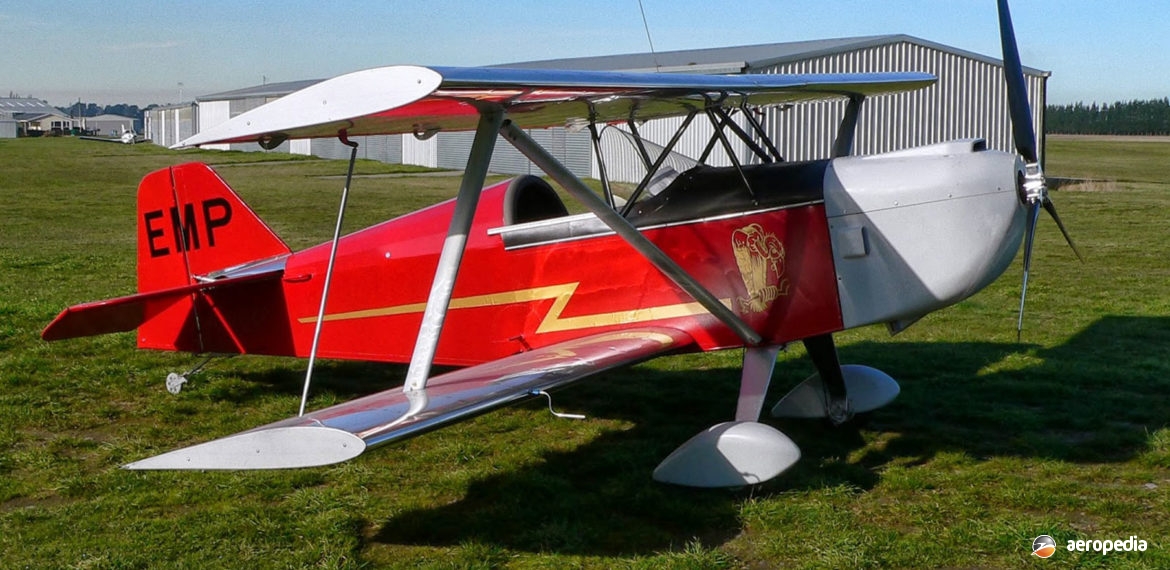Photograph:
First New Zealand Acrolite 1C ZK-EMP (c/n 126)at Rangiora in 2013 (NZCIVAIR)
Country of origin:
Canada
Description:
Single-seat light sport biplane
Power Plant:
One 60 kw (80 hp) Rotax 912UL four-cylinder horizontally-opposed liquid-and-air-cooled engine
Specifications:
- Wingspan: 6.09 m (20 ft)
- Length: 5 m (17 ft)
- Height: 2 m (6 ft)
- Wing area: 12.36 m² (133 sq ft)
- Max speed: 210 km/h (130 mph)
- Cruising speed: 176 km/h (109 mph)
- Stalling speed: 72 km/h (45 moh)
- Range: 402 km (250 miles)
- Fuel capacity: 34 litres (7.5 Imp gals)
- Empty weigh: 205 kg (452 lb)
- Loaded weight: 362 kg (798 lb)
History:
In 1985 the Aircraft Spruce & Specialty Company of Corona, California sponsored the design and construction of a light aircraft, the goal being to develop a new homebuilt aircraft that could be easily constructed from plans and / or building instructions using commonly available materials. Ronald Wilson designed the Acrolite and the first aircraft was shown at the 1996 EAA Convention at Oshkosh in Wisconsin, USA. Eventually Acrolite was formed by Messrs Peter Eisenbach, Harold Spithoff, Vern Ennis and Ron Wilson to market a number of designs, and Aircraft Spruce & Specialty Company supplied plans and material kits for the aircraft.
First model was the prototype Model 1A fitted with a 28 kw (38 hp) Kawasaki 440 engine. Other examples had the 30 kw (40 hp) Rotax 447 engine. This was followed by the 1B biplane, aimed at the entry-level sportsman aerobatics market with a 60 kw (80 hp) Rotax 912UL engine. Examples have been built with Rotax 582 or 618 engines. The next model was the 1C, also aimed at the single-seat sportsman aerobatics market, examples being fitted with Rotax 582 and 618 engines, Rotax 912UL and 912ULS engines, Rotax 914 and Hirth F-30 engines.
Other designs included the 1M single-seat high-wing strut-braced monoplane with Rotax 447, 503 and 582 engines. The 2M monoplane was a two-seater in tandem high-wing strut-braced model for the Canadian advanced ultralight category and was first flown in 1994. Engines installed have included the Rotax 582, Rotax 618, Rotax 912UL and Jabiru 2200. The 1T was a triplane model for aerobatics and cross-country work.
Development of the series took place at Kakabeka Falls, Ontario Canada and all models were either single or two-seaters, with a fixed tailwheel undercarriage. The fuselage was made from welded 4130 steel tube. The wings were of aluminium stressed skin construction with a box section main spar, a channel section rear spar and strut-braced, built entirely of 2024-T3 aluminium. The wing could be built of wood using a built up main spar and ribs, plywood sheeted and fabric covered. The ailerons were full span aluminium tube and static balanced. The Model 1A won the Canadian Owners and Pilots Association Good Show award in 1998 and the 1B was a finalist in the 1995 Aircraft Spruce & Specialty Scratchbuild Design Contest.
First of the type completed in this region became ZK-EMP² (c/n 126) at Rangiora, NZ and was completed in 2013. This aircraft was powered by a 76 kw (102 hp) Hirth 3003E fuel-injected engine driving a Powerfin propeller.
An example of the Acrolite 1B has been completed in Australia, registered under RAA Regulations as 19-7099 (c/n 99-005) in March 2009, and fitted with a 60 kw (80 hp) Jabiru 2200 engine. It had disc brakes, a Matco steerable tailwheel, and ailerons on both the upper and lower wings. It has been based at Goulburn, NSW.

